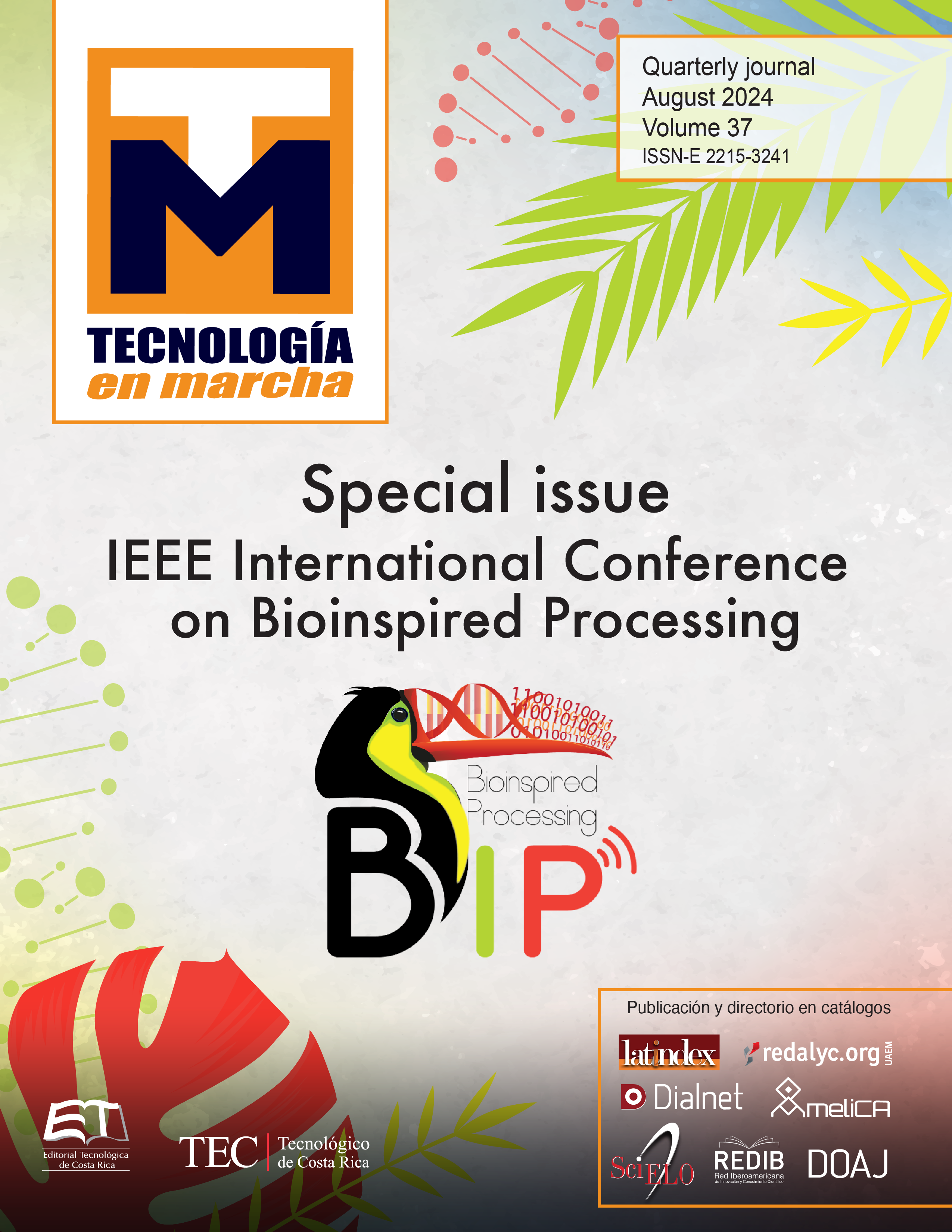Preliminary analysis of acoustic detection of the Red-throated Caracara in northern Costa Rica
Main Article Content
Abstract
The noisy Red-Throated Caracara (Ibycter americanus) is a species whose population has
inexplicably declined across much of its range and is now rare in the Pacific and Caribbean
slopes of Costa Rica. Advances in automatic acoustic detection have transformed bird ecology,
allowing researchers to analyze bird populations using pattern matching algorithms, machine
learning, and random forest models. Although these studies are limited in the country, it
represents an area with great interdisciplinary potential for technological advances. This study
focused on the use of Pattern Matching to detect the presence of the Red-Throated Caracara
in northern Costa Rica using a large number of sound recordings and its validation with metrics
such as Accuracy, Precision Negative predictive value, Sensitivity, Specificity and Unweighted
average recall. The results showed a moderate performance of the model by obtaining accuracy
and precision values of 0.71 compared to the values obtained in other investigations in which
the reported model was used. Therefore, we suggest exploring new techniques and methods to
improve the detection of the species, considering the particular acoustic structure, the repertoire
of sounds of the species and similarities with vocalizations of other species. This similarity
could indicate a supposed anti-predator defense behavior by “imitating” the sounds of other
species with which it shares habitat. To optimize this acoustic detection, we recommend using
complementary techniques such as noise filters that improve the quality and precision of the
data.
Article Details

This work is licensed under a Creative Commons Attribution-NonCommercial-NoDerivatives 4.0 International License.
Los autores conservan los derechos de autor y ceden a la revista el derecho de la primera publicación y pueda editarlo, reproducirlo, distribuirlo, exhibirlo y comunicarlo en el país y en el extranjero mediante medios impresos y electrónicos. Asimismo, asumen el compromiso sobre cualquier litigio o reclamación relacionada con derechos de propiedad intelectual, exonerando de responsabilidad a la Editorial Tecnológica de Costa Rica. Además, se establece que los autores pueden realizar otros acuerdos contractuales independientes y adicionales para la distribución no exclusiva de la versión del artículo publicado en esta revista (p. ej., incluirlo en un repositorio institucional o publicarlo en un libro) siempre que indiquen claramente que el trabajo se publicó por primera vez en esta revista.
References
Ramírez‐Albores, Jorge E., et al. “Insights for protection of high species richness areas for the conservation of
Mesoamerican endemic birds”. Diversity and Distributions, vol. 27, no 1, p. 18-33,2021.
Chassot, Olivier; Monge-Arias, G. “Connectivity conservation of the Great Green Macaw’s landscape in Costa
Rica and Nicaragua (1994–2012)”. Parks, vol. 18, no 1, p. 61-69, 2012.
Mccann, Sean Michael. “The bird who kicked the wasp’s nest: Red-throated Caracara predation, nesting and
territorial behavior”. Doctoral Thesis. Simon Fraser University, 2014.
Dyer, Dale; Howell, Steve NG. “Birds of Costa Rica”. Princeton University Press, vol. 1, no 1, 2023.
Bardeli, Rolf, et al. “Detecting bird sounds in a complex acoustic environment and application to bioacoustic
monitoring”. Pattern Recognition Letters, vol. 31, no 12, p. 1524-1534, 2010.
Shonfield, Julia; Bayne, Erin M. “Autonomous recording units in avian ecological research: current use and
future applications”. Avian Conservation & Ecology, vol. 12, no 1, 2017.
XIE, Jiangjian, et al. “A review of automatic recognition technology for bird vocalizations in the deep learning
era”. Ecological Informatics, p. 101927, 2022.
Castro, Jorge; Vargas-Masís, Roberto; Alfaro-Rojas, Danny. “Deep multiple instance learning ensemble for the
acoustic detection of tropical birds”. 19th IEEE International Conference on Machine Learning and Applications
(ICMLA). IEEE. p. 264-269, 2020.
Vargas-Masís, Roberto, et al. “Acoustic detection of Red-capped Manakin (Ceratopipra mentalis) in Sarapiquí,
Costa Rica”. 3rd International Conference on BioInspired Processing (BIP). IEEE. p. 1-5, 2021.
Vargas-Masís, Roberto, et al. “Automated bird acoustic detection at Las Arrieras Nature Reserve in Sarapiquí,
Costa Rica”. 4th International Conference on BioInspired Processing (BIP). IEEE. p. 1-8, 2022.
Thiollay, Jean‐Marc; Jullien, Mathilde. “Flocking behaviour of foraging birds in a neotropical rain forest and the
antipredator defence hypothesis”. Ibis, vol. 140, no 3, p. 382-394, 1998.
Ramirez, Angel David Pedroza, et al. “A comparative between mel frequency cepstral coefficients (MFCC)
and inverse mel frequency cepstral coefficients (IMFCC) features for an automatic bird species recognition
system”. Latin American Conference on Computational Intelligence (LA-CCI). IEEE, 2018. p. 1-4, 2018.
Sun, Yuren, et al. “Classification of animal sounds in a hyperdiverse rainforest using convolutional neural networks with data augmentation.” Ecological Indicators 145 (2022): 109621.
Brooker, Stuart A., et al. “Automated detection and classification of birdsong: An ensemble approach”.
Ecological Indicators, vol. 117, p. 106609, 2020.
Muraina, Ismail. “Ideal dataset splitting ratios in machine learning algorithms: general concerns for data scientists and data analysts”. 7th International Mardin Artuklu Scientific Research Conference, 2022.
Bardeli, Rolf, et al. “Detecting bird sounds in a complex acoustic environment and application to bioacoustic
monitoring”. Pattern Recognition Letters, vol. 31, no 12, p. 1524-1534, 2010.

